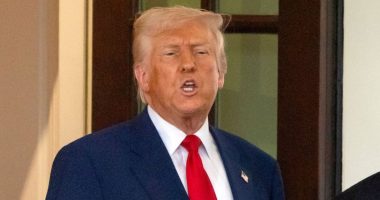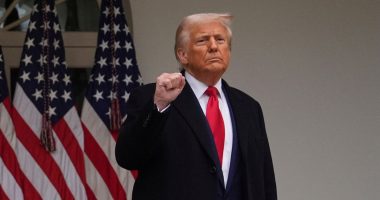
In this courtroom sketch, former Trump organization employee Jeffrey McConney testifies regarding payments made to Michael Cohen. Monday, May 6, 2024, in New York. (Elizabeth Williams via AP)
The precise financial arrangement between the Trump Organization and Michael Cohen following the Stormy Daniels payoff was explained to Manhattan jurors in testimony and exhibits on Monday morning.
Jeffrey McConney, a since-retired accountant who worked his way up the ranks to serve for years as the company’s controller, took the stand as the first witness called by the state during the eighth day of testimony in former President Donald Trump’s hush-money trial.
The witness described his roles as overseeing the general ledger, accounts payable and receivable, expense payments, 401(k) issues, and payroll processing. Part of those responsibilities included a direct role in processing several monthly checks paid to Cohen throughout 2017.
The contours of these payments, totaling $420,000, were sketched out on Trump Organization stationary after a discussion McConney had with then-CFO and trustee Allen Weisselberg, the witness testified — in monthly increments of $35,000. The latter would go on to be convicted of tax evasion over unrelated financial crimes.
Discussing his math on the note, which was shown to jurors as one of the state’s exhibits, McConney admitted an error in the bonus that Cohen was to be paid that year and said he “made a boo boo,” according to a report by Law&Crime Network reporter Terri Austin.
The state’s theory of the case is that Cohen was methodically repaid by the 45th president — via forged paperwork from his namesake family business — for $130,000 the erstwhile fixer spent to stop Daniels from going to the press about an alleged tryst with Trump.
In addition to the amount Cohen paid to Daniels using a home-equity loan from First Republic Bank, he was also reimbursed $50,000 for hiring a company called RedFinch to game online polls in then-candidate Trump’s favor in 2016, notes from Weisselberg showed, according to a report by Just Security fellow Adam Klasfeld.
Getting from $180,000 to $420,000 still required a bit more work, however, McConney explained. The total amount was “grossed up” and doubled to account for the income tax hit of so many lump sum payments, according to the witness. And then Cohen was given a $60,000 bonus, according to the Weisselberg note. Jurors were later shown the Cohen payment math broken down on corporate paper stock where McConney initially listed the onetime lawyer’s bonus as $50,000 for the year — the source of the admitted “boo boo.”
The defense, while not particularly boxed in to such a line of argument, appears likely to make the case that at the time of the payments, Cohen actually was being paid for being a lawyer. At the very least, that’s what the Trump Organization documentation says.
“Please pay from the Trust,” McConney wrote in an email to the then-accounts payable supervisor. “Post to legal expenses. Put ‘retainer for the months of January and February 2017’ in the description.”
Jurors were shown a series of emails between Cohen, McConney, Weisselberg and other employees down the accountant department’s pecking order. The sum and substance of those emails, prosecutors hoped, showed a fairly straightforward series of invoices from Cohen that resulted in payments from the Trump Organization.
“Just a reminder to get me the invoices you spoke to Allen about,” McConney reportedly wrote to Cohen in a Feb. 14, 2017 email.
Cohen then supplied the invoice that same day.
“Ok to pay as per agreement with Don and Eric,” Weisselberg replied.
Over the course of the arrangement, there were 11 invoices sent, 11 checks paid, and 12 ledger entries in the corporate account — two of Cohen’s payments were accounted for in one invoice and concomitant check. Each of those documents, combined, make up the 34 charges leveled against the former president.
The state was able to elicit testimony from McConney that he never saw the referenced retainer agreement — a point likely made in service of the argument that Cohen’s alleged legal work was nonexistent. The defense, led by attorney Emil Bove, later sought to clean that up by having McConney testify that a retainer agreement could be verbal.
McConney, for his part, testified that he did not know whether Cohen actually performed any legal work. The witness also said the invoices he received from Cohen were consistent with the $420,000 figure arrived at during his doubly documented discussion with Weisselberg and that all debts owed to Cohen for reimbursements were paid.
Eventually, jurors learned, the source of the payments changed.
The Trump Organization’s trust account sent three payments to Cohen totaling $105,000; payments that required the signatures of two out of the three people — Weisselberg, Eric Trump, and Donald Trump, Jr. But in April 2017, the funds were paid by the then-president himself — out of his personal account — to the tune of $315,000.
Bove, on cross-examination, sought to put forward the notion there was nothing untoward about switching the payout accounts from the corporate to the personal checking. The witness did not disagree.
Asked whether he spoke with Trump — or with Cohen; aside from emails — about the payments, McConney said he did not.
But, when pressed as to whether Cohen was really acting as a Trump or Trump family lawyer, the witness offered one clarification that likely did not inure much to the benefit of the defense: there was not a single Trump Organization ledger entry for Cohen’s legal services in 2018.
Have a tip we should know? [email protected]







